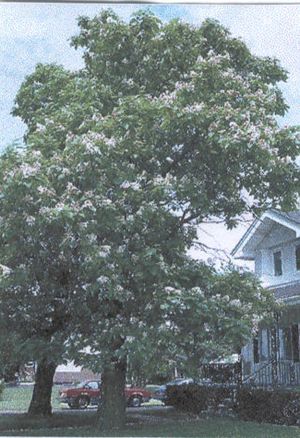Catalpa speciosa
Northern Catalpa
Northern Catalpa is a medium to large, deciduous tree that typically grows with an irregular, open-rounded to narrow-oval crown. It typically occurs along streams, bluff bases and in both low and upland woods.Large, broad oval to oblong leaves are light green to yellow green above and hairy below. Foliage turns an undistinguished yellow in fall. Flowers can be a real showstopper, however. Bell-shaped, orchid-like, white flowers (to 2" long) with purple and yellow inner spotting appear in panicles in late spring. Flowers are followed by long, slender, green seedpods (12-22" long). The seedpods mature in fall to dark brown and then split open lengthwise to release the seeds within. Seedpods give rise to the common name of cigar tree. Bark of mature trees is fissured, prominently ridged and pale gray-brown.
Additional Information:
Height
40-70 Feet
|
 |
Spread
35-50 Feet
|
USDA Hardiness Zone 4-8
Home Owner Growing and Maintenance Tips:
Easily grown in average, medium wet to wet, well-drained soils in full sun to part shade. Tolerant of a wide range of soil conditions including both wet and dry soils. Tolerant of seasonal flooding. Prefers moist fertile soil.
Characteristics & Attributes
Hydrologic Designation
|
Root
|
Season of Interest
| • |
Mid (May-June) |
| • |
Late (July-frost) |
|
Soil Moisture
|
Special Features
|
Sun Exposure
|
USFS MO Ecological Map
|
Wildlife Benefit
|

